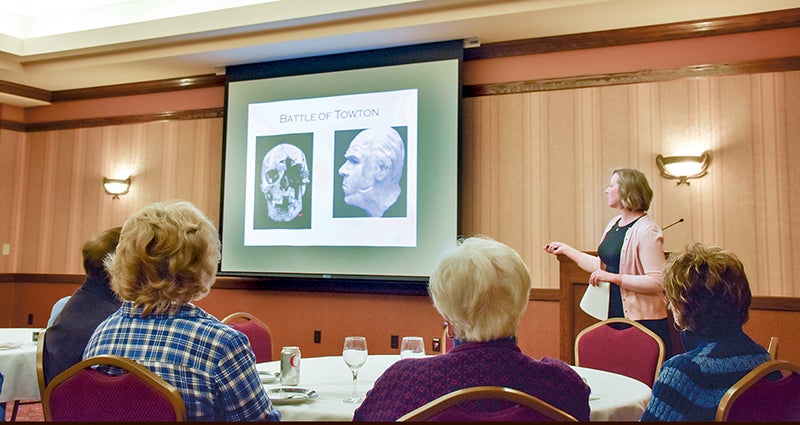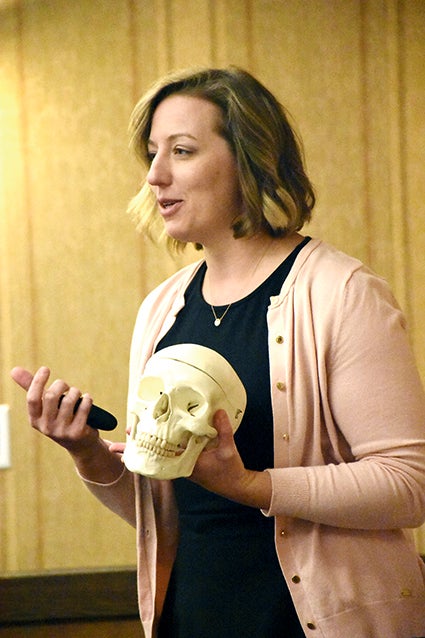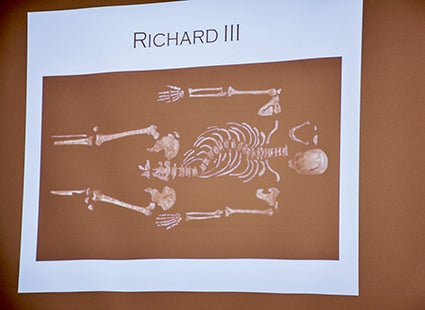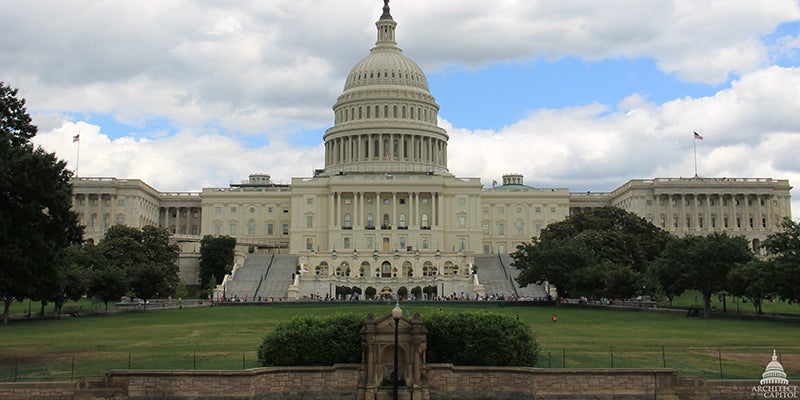Bare bone details; Study of bones enriches the understanding of people, cultures
Published 10:49 am Tuesday, January 10, 2017

- Elena Haymond discusses wounds found on remains of the Battle of Towton, during the War of the Roses, fought in 1461. Photos by Deb Nicklay/deb.nicklay@austindailyherald.com
When Elena Haymond picks up the jawbone of someone long dead, you can bet she will be looking at far more than whether the owner had a good dentist.
“The reason I study teeth is because they preserve very well; they hang around when bones don’t. They create this record of our lives,” Haymond told an audience at the Hormel Historic Home Monday night, a monthly meeting of History Happy Hour, a partnership between the home and the Mower County Historical Society. Haymond’s talk, “The Archeology of Bones” focused on what can be learned from excavation of remains.
Haymond, an anthropology instructor at Riverland Community College, knows a whole lot about bones — especially their teeth, her special area of research within the field of osteoarchaeology. Her studies have taken her to Scotland, where she did her work for her master’s degree, and Bulgaria. She has studied bones ranging in age from 500 to 2,000 years old.
The field focuses on the excavation and analysis of bones that can often lead to discovering the cause of death, but not necessarily in the way a forensic anthropologist might, popularized in such television shows as “Bones.”
Discovering a cause of death is only one item in a raft of analysis that more often leads scientists to an understanding of people, their history and their cultures.

Elena Haymond discusses a point of bone analysis during the talk, “The Archaelogy of Bones” on Monday night at the Hormel HIstoric Home, part of its Happy History Hour series.
It is not a science for the impatient.
Analysis takes time and depending on the condition and age of the bones, study can be frustrating at times. Children’s bones are easier to read due to their lack of bone fusion, which occurs in adulthood. Once a person reaches adulthood, other clues must be found to accurately determine age and other details.
When information can be gleaned, the result “gives us context to the historical and archaeological record, about the times in which the people lives and died,” she said.
Among the most famous case in point came with the 2012 recovery of the remains of England’s 15th century monarch, Richard III. Shakespeare’s famous portrait of the king — hunchbacked and with a disabled arm — described in his play “Richard III” was dispelled when it was found that while the king suffered curvature of the spine, “it would not have caused the hump” depicted so often, Haymond said. And his withered arm? Just a fanciful notion not supported by his skeleton, she said.
“As you see,” as she showed a photograph of the remains, “he has two very well formed arms.”
Richard III died from wounds to his head suffered during the Battle of Bosworth. History said his helmet flew off, which would account as to why he died from head wounds. The rest of his body was covered by armor and would have protected him. Facial reconstruction showed a startling likeness to his well-known portraits.

The rearticulated skeleton of Richard III, found under a parking lot near Leicester, England, in 2012.
Haymond’s favorite part of skeletal remains are its teeth, and what it can reveal due to its lack of remodeling — or rather, formation of new bone tissue, such as happens with a broken bone. Teeth have no such process.
As a result, the record provided by teeth is untouched by changes due to remodeling. They also are not as affected by poor soil conditions as the rest of the body’s skeletal make up.
“They are a record of our life in our mouth,” she said.
Teeth can have a mother lode of information. Cavities could indicate a high carbohydrate diet; abscesses can indicate a lack of any dental care. A process called enamel hypoplasia can show if a person perhaps experienced nutritional stress — lack of food due to a poor year of crops, a drought, or warfare that prevented easy access to food.
“Teeth can tell us a lot — and I find that fascinating,” she said.
Osteoarchaeologists can be enlisted to solve crimes, but most often they are tapped in the area of repatriation of remains, such as the recovery and identification of remains of those missing during wartime, plane crashes, or during a disastrous event such as 9-11.
All examinations take time, she noted. Having someone like the TV character Temperance Brennan from “Bones” look at a bone and immediately identify age and other details is the stuff of fiction.
“It just doesn’t happen that way,” she said with a chuckle.





